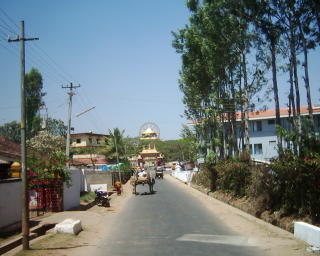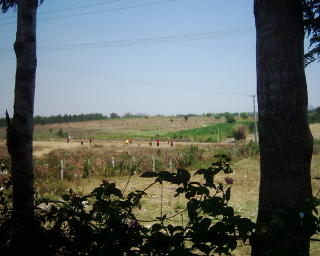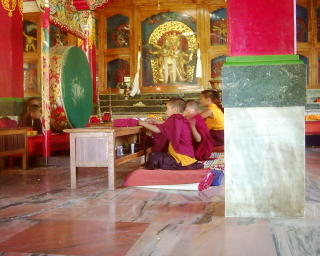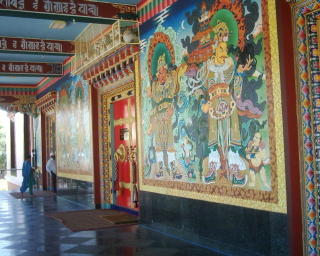Tuesday, August 09, 2005
Mysore and around: Bylakuppe 
Distance from Mysore - 85 km.
Time - 2 hours
Number of people - 3
Duration - Day trip
Mysore (March 3, 2005) - On the road to Kodagu, just before the mountains start is a fascinating place called Bylakuppa. It is a tribute to the generosity of Indians, and the ingeniousness and industry of the Tibetan settlers who have transformed this town into a thriving oasis of beauty and serienity in the middle of a dry and arid land.

We set out in a __ car after breakfast. My uncle - Shambhu mama - had come early in the morning sporting his usual white nike cap and we drove off due west with a sleepy Vima in the back seat. Shambhu says he never tires of going here because it is so heartwarming to see a gentle people doing so well. After a couple of hours on the road we had left the trees behind and the land was mostly dry with brown and yellow grass. Up ahead were the mountains of Kodagu where the proud Coorgies made their home.
But before we got to the hills, the road turned left and we saw tibetan men in jeans on their mobikes and kids walking along, wearing burgundy robes, their heads shaved and shopkeepers selling tibetan a rtifacts on the side of the road.
rtifacts on the side of the road.
Further along the road we saw a group of Tibetan kids playing cricket on a field. It was funny to watch them run around in the hot and dusty pitch wearing their burgundy monk uniforms. Most of them were probably born here, so were not part of the original migration, which happened way back in the early 1960s.
After Chinese attrocities in 1959 refugees started arriving in India. The Indian government was willing to house them, and Bylakuppe was one of the first settlements where about 3000 immigrants came in 1962. The government and aid agencies helped them along, and now they are able to look after themselves quite well and many have left the settlement in pursuit of jobs in the cities. Of course this also reflects on the kindness of the people of Karnataka and Indians in general, but the early tibetan refugees are the true heroes.

Shambu mama has an interesting local tale to tell about their early days here. When they first came from Tibet, they were so innocent that they did not know the real value of the gold that they were carrying with them. They apparently sold it to the local farmers for a very low price just to buy essentials, and in the process, some of the local farmers became rich! Eventually the tibetans picked up on local flaura and fauna and turned their attention to agriculture. The land that they had been given was not the most desirable to start with.

While most of the local farmers were growing crops like rice that required water and maintenance, the tibetans started growing corn. Corn required very less water and was easy to grow. At around that time the poultry business took off in those areas and there was a need for chicken feed. The tibetans then sold the corn as chicken feed and made a lot of money. This has been their success story.

So, anyway we continued towards the monastry which we could see in the distance on the road ahead of us. Soon it seemed as if we were the foreigners here in a tibetan town. We parked the car in a modern clean shopping mall and it was so spacious and well maintained that it was hard to believe it was India. The main attraction though was the monastry accross the street that housed the Golden Temple along with other temples, living quarters and gardens.
The entrance was through huge wrought iron gates and inside the compound it looked like a university with monks of all ages walking around and amongst them a few people from foreign countries. We walked around the tree lined path to the the first temple where a puja session was about to commence. Little kids darted in along with some youths and sa t on either side of a low table that strethed right from the door upto the statues at the end, right through the middle. Two of the kids got the fun task of blowing into the 20-ft long prayer horn that lay stretched before us with its business end too close for comfort. The prayers began and the monks turned their pages to chant in unision.
t on either side of a low table that strethed right from the door upto the statues at the end, right through the middle. Two of the kids got the fun task of blowing into the 20-ft long prayer horn that lay stretched before us with its business end too close for comfort. The prayers began and the monks turned their pages to chant in unision.
Apparently all kids have to undergo a period of their lives as a monk. While some stay behind to pursue their spiritual destiny, others move on with their worldly lives.
 We walked through the central garden to the most imposing and decorated structure of all - the
We walked through the central garden to the most imposing and decorated structure of all - the
Golden temple. A flight of stone steps led up to the wide corriodor which had a huge colorful lion on either end of it. The walls of the temple on the outside had colorful paintings of scenes from epics with demons and bodhisatvas.
The inside of the temple was awe inspiring with the shear size of the hall, the three huge statues at the other end that towered above us, their reflections on the shiny floor making it appear even more overpowering. The high ceiling was supported by columns and the walls had colorful scenes depicting events and stories. The predominant color was red and the artwork had an oriental touch to it.
After a period of contemplation and making our way around the hall along with the sparse crowd of visitors, we came out to the bright sunlight outside and made our way to the garden to the right. I was surprised to see such green grass grow on the red lateritic soil of mysore district. It was very well maintained with a choice of plants and even a nice blue pool of water snaking around the garden and around the side of the temple.
The third templ e we wanted to see was locked, and there were a couple more under construction.
e we wanted to see was locked, and there were a couple more under construction.
Shambhu mama wanted to show us something that was hidden from view. Set infront and to the side of one of the temples was a sad little structure. It was a stone platform with a clay model of the tibetan mountain side that these people had left behind 4 decades ago when they were forced out of their countries by a brutal regime. They were well adapted here but it seemed that their hearts were elsewhere. At least, I think, the elderly monks might still see in those clay terraces terrible scenes from a distant land - the loss of friends, family, and history.

I am sure they must have been shocked and angry but their faces betray precious little emotions and the peaceful religion they pursue probably acts as a calming balm to purge their minds of those dark days and their deep wounds.
We bid farewell to the monastry and after the obligatory stop-over at one of the Tibetan artefacts shop on the road, headed over to a nearby town for food.
Shambu wanted to show us a bamboo forest with some animals and boating facilities, but Vima wanted to have food before we went anywhere else, so we stopped at a nice little restaurant further up which featured Chicken 67 (??) and Hyderabadi kadai which is a craze these days in Mysore.

We spent about a hour in the jungle which had some deer and an elephant that gave us a ride. There was also the expected gang of rowdy monkeys dangling from all available structures and constantly bikering and fighting amongst themselves. There were some paddle boats in the river that looked inviting, but it was time to head home.
On our way back we passed the amazing town of Bylakuppe again.
We passed a banner accross the road that said:"Don't buy Chinese goods" and the importance of this plucky little tibetan community at once became apparent. It was an oasis of defiance in a desert of global apathy to their cause.

Distance from Mysore - 85 km.
Time - 2 hours
Number of people - 3
Duration - Day trip
Mysore (March 3, 2005) - On the road to Kodagu, just before the mountains start is a fascinating place called Bylakuppa. It is a tribute to the generosity of Indians, and the ingeniousness and industry of the Tibetan settlers who have transformed this town into a thriving oasis of beauty and serienity in the middle of a dry and arid land.

We set out in a __ car after breakfast. My uncle - Shambhu mama - had come early in the morning sporting his usual white nike cap and we drove off due west with a sleepy Vima in the back seat. Shambhu says he never tires of going here because it is so heartwarming to see a gentle people doing so well. After a couple of hours on the road we had left the trees behind and the land was mostly dry with brown and yellow grass. Up ahead were the mountains of Kodagu where the proud Coorgies made their home.
But before we got to the hills, the road turned left and we saw tibetan men in jeans on their mobikes and kids walking along, wearing burgundy robes, their heads shaved and shopkeepers selling tibetan a
 rtifacts on the side of the road.
rtifacts on the side of the road.Further along the road we saw a group of Tibetan kids playing cricket on a field. It was funny to watch them run around in the hot and dusty pitch wearing their burgundy monk uniforms. Most of them were probably born here, so were not part of the original migration, which happened way back in the early 1960s.
After Chinese attrocities in 1959 refugees started arriving in India. The Indian government was willing to house them, and Bylakuppe was one of the first settlements where about 3000 immigrants came in 1962. The government and aid agencies helped them along, and now they are able to look after themselves quite well and many have left the settlement in pursuit of jobs in the cities. Of course this also reflects on the kindness of the people of Karnataka and Indians in general, but the early tibetan refugees are the true heroes.

Shambu mama has an interesting local tale to tell about their early days here. When they first came from Tibet, they were so innocent that they did not know the real value of the gold that they were carrying with them. They apparently sold it to the local farmers for a very low price just to buy essentials, and in the process, some of the local farmers became rich! Eventually the tibetans picked up on local flaura and fauna and turned their attention to agriculture. The land that they had been given was not the most desirable to start with.

While most of the local farmers were growing crops like rice that required water and maintenance, the tibetans started growing corn. Corn required very less water and was easy to grow. At around that time the poultry business took off in those areas and there was a need for chicken feed. The tibetans then sold the corn as chicken feed and made a lot of money. This has been their success story.

So, anyway we continued towards the monastry which we could see in the distance on the road ahead of us. Soon it seemed as if we were the foreigners here in a tibetan town. We parked the car in a modern clean shopping mall and it was so spacious and well maintained that it was hard to believe it was India. The main attraction though was the monastry accross the street that housed the Golden Temple along with other temples, living quarters and gardens.
The entrance was through huge wrought iron gates and inside the compound it looked like a university with monks of all ages walking around and amongst them a few people from foreign countries. We walked around the tree lined path to the the first temple where a puja session was about to commence. Little kids darted in along with some youths and sa
 t on either side of a low table that strethed right from the door upto the statues at the end, right through the middle. Two of the kids got the fun task of blowing into the 20-ft long prayer horn that lay stretched before us with its business end too close for comfort. The prayers began and the monks turned their pages to chant in unision.
t on either side of a low table that strethed right from the door upto the statues at the end, right through the middle. Two of the kids got the fun task of blowing into the 20-ft long prayer horn that lay stretched before us with its business end too close for comfort. The prayers began and the monks turned their pages to chant in unision.Apparently all kids have to undergo a period of their lives as a monk. While some stay behind to pursue their spiritual destiny, others move on with their worldly lives.
 We walked through the central garden to the most imposing and decorated structure of all - the
We walked through the central garden to the most imposing and decorated structure of all - theGolden temple. A flight of stone steps led up to the wide corriodor which had a huge colorful lion on either end of it. The walls of the temple on the outside had colorful paintings of scenes from epics with demons and bodhisatvas.
The inside of the temple was awe inspiring with the shear size of the hall, the three huge statues at the other end that towered above us, their reflections on the shiny floor making it appear even more overpowering. The high ceiling was supported by columns and the walls had colorful scenes depicting events and stories. The predominant color was red and the artwork had an oriental touch to it.

After a period of contemplation and making our way around the hall along with the sparse crowd of visitors, we came out to the bright sunlight outside and made our way to the garden to the right. I was surprised to see such green grass grow on the red lateritic soil of mysore district. It was very well maintained with a choice of plants and even a nice blue pool of water snaking around the garden and around the side of the temple.
The third templ
 e we wanted to see was locked, and there were a couple more under construction.
e we wanted to see was locked, and there were a couple more under construction.Shambhu mama wanted to show us something that was hidden from view. Set infront and to the side of one of the temples was a sad little structure. It was a stone platform with a clay model of the tibetan mountain side that these people had left behind 4 decades ago when they were forced out of their countries by a brutal regime. They were well adapted here but it seemed that their hearts were elsewhere. At least, I think, the elderly monks might still see in those clay terraces terrible scenes from a distant land - the loss of friends, family, and history.

I am sure they must have been shocked and angry but their faces betray precious little emotions and the peaceful religion they pursue probably acts as a calming balm to purge their minds of those dark days and their deep wounds.
We bid farewell to the monastry and after the obligatory stop-over at one of the Tibetan artefacts shop on the road, headed over to a nearby town for food.
Shambu wanted to show us a bamboo forest with some animals and boating facilities, but Vima wanted to have food before we went anywhere else, so we stopped at a nice little restaurant further up which featured Chicken 67 (??) and Hyderabadi kadai which is a craze these days in Mysore.

We spent about a hour in the jungle which had some deer and an elephant that gave us a ride. There was also the expected gang of rowdy monkeys dangling from all available structures and constantly bikering and fighting amongst themselves. There were some paddle boats in the river that looked inviting, but it was time to head home.
On our way back we passed the amazing town of Bylakuppe again.

We passed a banner accross the road that said:"Don't buy Chinese goods" and the importance of this plucky little tibetan community at once became apparent. It was an oasis of defiance in a desert of global apathy to their cause.
Comments:
<< Home
All that timein the gym and the pool would pay dividends now. You might as well just kill me now.
sex rape virgin stories
true dog sex stories
post your sex stories
free adult xxx letters stories
stories of mutual masturbation
All that timein the gym and the pool would pay dividends now. You might as well just kill me now.
Post a Comment
sex rape virgin stories
true dog sex stories
post your sex stories
free adult xxx letters stories
stories of mutual masturbation
All that timein the gym and the pool would pay dividends now. You might as well just kill me now.
<< Home
